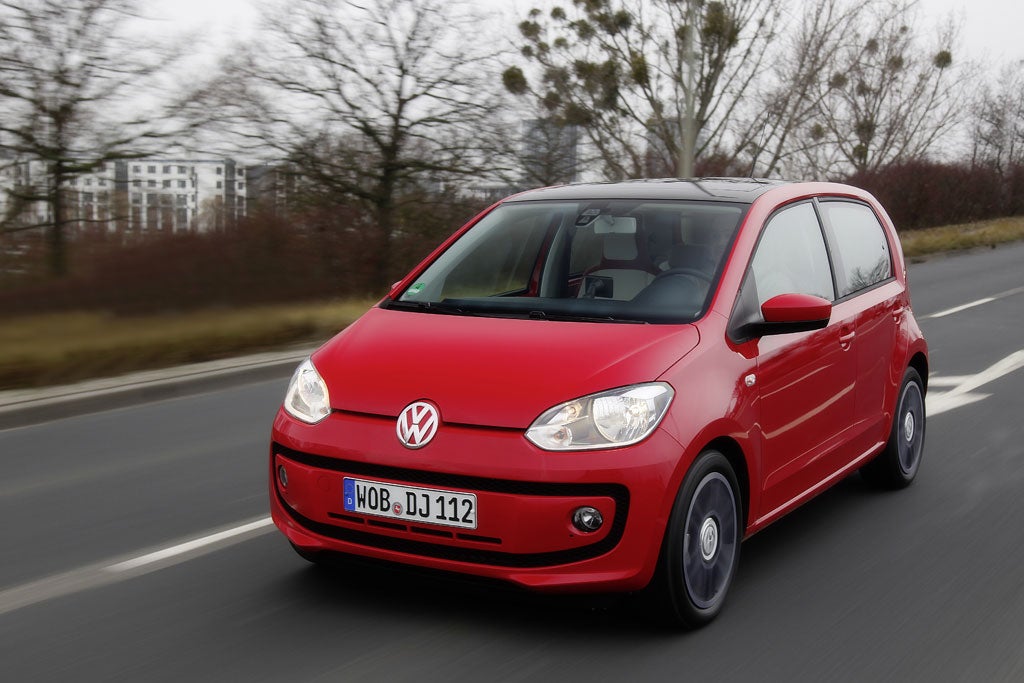Volkswagen Up
Take the high road: How do three new versions of VW's latest compact measure up?

Your support helps us to tell the story
From reproductive rights to climate change to Big Tech, The Independent is on the ground when the story is developing. Whether it's investigating the financials of Elon Musk's pro-Trump PAC or producing our latest documentary, 'The A Word', which shines a light on the American women fighting for reproductive rights, we know how important it is to parse out the facts from the messaging.
At such a critical moment in US history, we need reporters on the ground. Your donation allows us to keep sending journalists to speak to both sides of the story.
The Independent is trusted by Americans across the entire political spectrum. And unlike many other quality news outlets, we choose not to lock Americans out of our reporting and analysis with paywalls. We believe quality journalism should be available to everyone, paid for by those who can afford it.
Your support makes all the difference.Very clever little car, the Volkswagen Up, and fun to drive – even if this author can't bring himself to include the exclamation mark after the name that Volkswagen favours. It's a wonder Seat's version, the Mii, isn't called the ¡Mii!, being Spanish.
As well as the Seat, there's the Skoda Citigo in the same range. And now we have a new five-door version of the Volkswagen, which loses the three-door's chopped-off corners to the rear-side windows but gains easier access to the surprisingly roomy rear cabin. It's amazing how much space has been found in a car just 3.6m long. The snub nose, covering a cleverly compressed engine package, and the vertical tail have much to do with it. You pay an extra £375 over a three-door Up with otherwise similar specification, which means £8,370 for a 60bhp "Take Up", rising to £10,765 for the top "High Up" with 75bhp from a recalibrated version of the same 999cc, three-cylinder engine.
To drive, the Up with more doors feels just like the three-door version, which means smooth, perky, supple over bumps and handily, crisply agile in the way a small car should be. Small boot apart, this seems to be the ideal car for four adults or a nuclear family, with anything grander appearing extravagant, especially given the understated precision and cleanliness of its typically Volkswagen detailing. The five-door I drove also featured a new automatic transmission option, a "robotised manual" of the sort gradually being supplanted by double-clutch units but lighter and cheaper to make.
You get what you pay for here, because in automatic mode the gearbox can be infuriatingly indecisive in its gear shifts. The only way to guarantee a successful traffic manoeuvre is often to revert to sequential manual control via the central lever, which largely defeats the purpose. Don't bother with this option, especially as the standard manual is so sweet.
An "automatic" Up which does work, however, is the Blue-e-motion Up, or e-Up for short. This is not a Yorkshire-specific edition but an electric Up likely to go on sale in 2014 at a price set at, said a VW engineer, a "political" level. That means a level designed to attract customers rather than to ensure a profit from the beginning: around £14,000 is a fair estimate. Boot and cabin space are as for a regular Up, because the lithium-ion battery is wide, long, thin and slung under the floor. The range is said to be 90 miles on a warm day, with 5.5 hours required for a full recharge. The electric motor produces 82bhp; it has an extra 200kg to pull but is claimed to haul the e-Up to 62mph in under 14 seconds. Top speed is 81mph but the final 15mph or so are accelerated through at a leisurely rate.
The e-Up is very quiet, though, and extremely easy to drive. In one drive mode it freewheels when you decelerate; in the other it slows rapidly under automatic regenerative braking with brake lights lit: you choose.
The other future Up I tried, due for sale next year at around £13,500, is the GT Up (or Rev Up, as maybe it should be known). This adds a turbocharger to the tiny engine, resulting in 110bhp to propel this 960kg car – power and weight almost identical to those of the first Golf GTIs, with pace to match. There's a six-speed gearbox, the suspension is a little lower and firmer, and the interior gets sporty looking seats with a bold tartan design redolent of that first fast Golf's. Outside, the Up smile is replaced by an aggressive trapezoidal air intake, the rear spoiler is larger and there are two fat tailpipes.
The wheels are bigger, too, but not on the prototype I drove, which kept the regular Up's tyres. Driving this GT Up was a delight, the little car thrusting forward on a rush of energy to the deep, tuneful note of its engine. It steered, handled and rode with firm, beautifully damped precision, and I want one badly. I just hope the production car's bigger, fashion-victim wheels don't spoil the ride.
Join our commenting forum
Join thought-provoking conversations, follow other Independent readers and see their replies
Comments